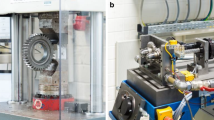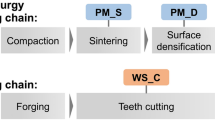Abstract
Gear wheels, the first examples of use in the Mesopotamian period, continue to develop with different forms and features together with advanced technologies. Within the scope of this study, the DMLS (direct metal laser sintering) technique, which is one of the latest technologies, was preferred as a method in the production of gears. A total of four different samples, including gears designed as hexagonal, radial, and gyroid lattice designed as lightweight, and gears using porous structure obtained with the DMLS hatch distance parameter, were compared in terms of mechanical strength. The tooth-breaking behaviors of the models tested in the physical test setup specially designed for the study were examined by SEM (scanning electron microscope), and the results were shared.





Similar content being viewed by others
Availability of data and material
The authors confirm that the data and material supporting the findings of this work are available within the article.
References
Yu W, Mechefske CK, Timusk M (2017) The dynamic coupling behaviour of a cylindrical geared rotor system subjected to gear eccentricities. Mech Mach Theory 107:105–122
Kurt C (2011) “Özel redüktör tasarımı,” Namık Kemal Üniversitesi
Hsu R-H et al (2019) Mathematical model of a vertical six-axis Cartesian computer numerical control machine for producing face-milled and face-hobbed bevel gears. J Mech Des 142(4)
Ramadani R et al (2021) Topology optimization and additive manufacturing in producing lightweight and low vibration gear body. Int J Adv Manuf Technol 113(11):3389–3399
Wu T, Wang G, Li J, Yan K (2019) Structure design and effects of conical gear roller on restraining rabbit ear defects during gear rolling. Int J Adv Manuf Technol 103(1):1621–1631
Bouzakis K-D, Lili E, Michailidis N, Friderikos O (2008) Manufacturing of cylindrical gears by generating cutting processes: a critical synthesis of analysis methods. CIRP Ann 57(2):676–696
Pisula JM, Budzik G, Przeszłowski Ł (2019) An analysis of the surface geometric structure and geometric accuracy of cylindrical gear teeth manufactured with the direct metal laser sintering (DMLS) method. Stroj Vestnik/J Mech Eng 65(2)
Bulduk ME (2020) “Doğrudan Metal Lazer Sinterleme Yöntemi ile Üretilen Latis Yapilarin Mikroyapi ve Mekanik Özelliklerinin İncelenmesi,” Kocaeli Üniversitesi
Nguyen DS, Vignat F (2016) A method to generate lattice structure for additive manufacturing. In IEEE International Conference on Industrial Engineering and Engineering Management (IEEM) pp 966−970
Çalışkan Cİ, Özer G, Coşkun M, Koç E (2021) Investigation of direct metal laser sintering downskin parameters’ sagging effect on microchannels. Int J Adv Manuf Technol 114(9):2567–2575
Lee J-Y, An J, Chua CK (2017) Fundamentals and applications of 3D printing for novel materials. Appl Mater Today 7:120–133
Nandy J, Sarangi H, Sahoo S (2019) A review on direct metal laser sintering: process features and microstructure modeling. Lasers Manuf Mater Process 6(3):280–316
Henry TC, Morales MA, Cole DP, Shumeyko CM, Riddick JC (2021) Mechanical behavior of 17–4 PH stainless steel processed by atomic diffusion additive manufacturing. Int J Adv Manuf Technol 114(7):2103–2114
Rokicki P et al (2016) Manufacturing of aircraft engine transmission gear with SLS (DMLS) method. Aircraft Engineering and Aerospace Technology: An International Journal
Tezel T, Topal ES, Kovan V (2019) Characterising the wear behaviour of DMLS-manufactured gears under certain operating conditions. Wear 440:203106
Ramadani R, Belsak A, Kegl M, Predan J, Pehan S (2018) Topology optimization based design of lightweight and low vibration gear bodies. Int J Simul Model 17(1):92–104
Bulduk ME, Ertürk AT, Coşkun M, Tarakçi G, Ergin U (2019) The microstructure and mechanical properties of porous structures produced from Alsi10mg by direct metal laser sintering. In AMC Turkey
Bodaghi M, Serjouei A, Zolfagharian A, Fotouhi M, Rahman H, Durand D (2020) Reversible energy absorbing meta-sandwiches by FDM 4D printing. Int J Mech Sci 2020(173):105451
Yi B, Zhou Y, Yoon GH, Saitou K (2019) Topology optimization of functionally-graded lattice structures with buckling constraints. Comput Methods Appl Mech Eng 354:593–619
Zhou B, Tian T (2021) A path planning method of lattice structural components for additive manufacturing. Int J Adv Manuf Technol 1–24
Khoda B, Ahsan AMMN, Shovon AN, Alam AI (2021) 3D metal lattice structure manufacturing with continuous rods. Sci Rep 11(1):1–17
Du Plessis A, Broeckhoven C, Yadroitsev I, Yadroitsava I, le Roux SG (2018) Analyzing nature’s protective design: the glyptodont body armor. J Mech Behav Biomed Mater 82:218–223
Wang H, Gu D, Lin K, Xi L, Yuan L (2019) Compressive properties of bio-inspired reticulated shell structures processed by selective laser melting. Adv Eng Mater 21(4):1801168
Abou-Ali AM, Al-Ketan O, Lee D-W, Rowshan R, Abu Al-Rub RK (2020) Mechanical behavior of polymeric selective laser sintered ligament and sheet based lattices of triply periodic minimal surface architectures. Mater Des 196:109100
Deshpande VS, Fleck NA, Ashby MF (2001) Effective properties of the octet-truss lattice material. J Mech Phys Solids 49(8):1747–1769
Nian Y, Wan S, Li X, Su Q, Li M (2019) How does bio-inspired graded honeycomb filler affect energy absorption characteristics? Thin-Walled Struct. 144:106269
Hu Z et al (2017) Design of ultra-lightweight and high-strength cellular structural composites inspired by biomimetics. Compos Part B Eng 121:108–121
Zhang W, Yin S, Yu TX, Xu J (2019) Crushing resistance and energy absorption of pomelo peel inspired hierarchical honeycomb. Int J Impact Eng 125:163–172
Miller W, Smith CW, Scarpa F, Evans KE (2010) Flatwise buckling optimization of hexachiral and tetrachiral honeycombs. Compos Sci Technol 70(7):1049–1056
Xu J et al (2018) Compressive properties of hollow lattice truss reinforced honeycombs (Honeytubes) by additive manufacturing: Patterning and tube alignment effects. Mater Des 156:446–457
Yang L, Harrysson O, West H, Cormier D (2015) Mechanical properties of 3D re-entrant honeycomb auxetic structures realized via additive manufacturing. Int J Solids Struct 69–70:475–490
Zhang L et al (2018) Energy absorption characteristics of metallic triply periodic minimal surface sheet structures under compressive loading. Addit Manuf 23:505–515
Khaderi SN, Deshpande VS, Fleck NA (2014) The stiffness and strength of the gyroid lattice. Int J Solids Struct 51(23):3866–3877
Michielsen K, Stavenga DG (2008) Gyroid cuticular structures in butterfly wing scales: biological photonic crystals. J R Soc Interface 5(18):85–94
Maskery I, Aboulkhair NT, Aremu AO, Tuck CJ, Ashcroft IA (2017) Compressive failure modes and energy absorption in additively manufactured double gyroid lattices. Addit Manuf 16:24–29
Yang L, Mertens R, Ferrucci M, Yan C, Shi Y, Yang S (2019) Continuous graded Gyroid cellular structures fabricated by selective laser melting: design, manufacturing and mechanical properties. Mater Des 162:394–404
Zhang S, Wei Q, Cheng L, Li S, Shi Y (2014) Effects of scan line spacing on pore characteristics and mechanical properties of porous Ti6Al4V implants fabricated by selective laser melting. Mater Des 63:185–193
Sefidgar ARP (2014) The craniomaxillofacial skeleton: New approaches in computational biomechanics and fracture stabilization. University of Toronto (Canada)
Bendsøe MP, Sigmund O (19954) Optimization of structural topology, shape, and material, vol 414. Springer
Ming W, Yu W, Qiu K, An Q, Chen M (2021) Modelling of the temperature distribution based on equivalent heat transfer theory and anisotropic characteristics of honeycomb core during milling of aluminum honeycomb core. Int J Adv Manuf Technol
Wang Z (2019) Recent advances in novel metallic honeycomb structure. Compos Part B Eng 166:731–741
Chen H-Y, Kwon Y, Thornton K (2009) Multifunctionality of three-dimensional self-assembled composite structure. Scr Mater 61(1):52–55
Simsek U, Akbulut A, Gayir CE, Basaran C, Sendur P (2020) Modal characterization of additively manufactured TPMS structures: comparison between different modeling methods. Int J Adv Manuf Technol
Gu D, Shen Y (2008) Processing conditions and microstructural features of porous 316L stainless steel components by DMLS. Appl Surf Sci 255(5):1880–1887
Aziz IAA, Idris DMND, Ghazali WM (2017). Investigating bending strength of spur gear: A review. In MATEC web of conferences, vol 90. p 1037
Civelek HA (2019) “Dişli Çarklarda Kırılma Davranışının Deneysel İncelenmesi,” Bursa Uludağ Üniversitesi
Stringer DB, Dykas BD, LaBerge KE, Zakrajsek AJ, Handschuh RF (2011) A new high-speed, high-cycle, gear-tooth bending fatigue test capability
Funding
This study was prepared within the scope of “ALUTEAM-Aluminum Test Training and Research Center,” which have been carried out by Fatih Sultan Mehmet Vakif University.
Author information
Authors and Affiliations
Contributions
Mustafa Enes BULDUK: literature and experimental authorship, gyroid gear CAD modeling, laboratory work, tables studies, references authorship. Cemal İrfan ÇALIŞKAN: physical test unit and lattice gears CAD modeling, design process, literature and discussion result section editing and authorship, figures, and table studies, laboratory work. Mert Coşkun: static analysis, analysis section writing and tables, DMLS productions, laboratory work. Gökhan Özer: literature authorship, SEM laboratory works, editorial, and translation. Ebubekir Koç: coordinator.
Ethics declarations
Ethical approval
The article follows the guidelines of the Committee on Publication Ethics (COPE) and involves no studies on human or animal subjects.
Consent to participate
Not applicable. The article involves no studies on humans.
Consent to publish
Not applicable. The article involves no studies on humans.
Conflict of interest
The authors declare no competing interests.
Additional information
Publisher's Note
Springer Nature remains neutral with regard to jurisdictional claims in published maps and institutional affiliations.
Rights and permissions
About this article
Cite this article
Bulduk, M.E., Çalışkan, C.İ., Coşkun, M. et al. Comparison of the effect of different topological designs and process parameters on mechanical strength in gears. Int J Adv Manuf Technol 119, 6707–6716 (2022). https://doi.org/10.1007/s00170-021-08405-4
Received:
Accepted:
Published:
Issue Date:
DOI: https://doi.org/10.1007/s00170-021-08405-4




